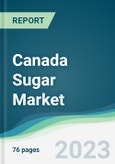The Canadian sugar market is expected to grow at a compound annual growth rate of 2.48% over the analysed period to reach a market size of US$667.165 million by 2028 from US$561.932 million in 2021.
Sugar is a key and essential part of Canada's food supply. This industry has made a considerable contribution to the national economy. Further, the sector has functioned in accordance with global market norms and has continued to offer Canadians a consistent supply of refined sugar that is of excellent quality and affordable prices.Moreover, the food processing industry in Canada benefits significantly from the country's globally competitive sugar producers, which support about 100, 000 employments in Canada's manufacturing sectors that require sugar. However, the industry's expansion is significantly impacted by the rising incidence of lifestyle-related health issues including obesity and diabetes linked to excessive sugar consumption.
Rising demand in the food and beverages industry
The Canadian sugar market will be driven by rising consumer demand for sugar as a sweetener in food and beverage items. The sugar market has expanded steadily because it is used as a source of energy, trace levels of minerals, and antioxidants in the food and beverage industries. For instance, Sucro Can Canada stated in November 2022 that it would increase the refinery's capacity to produce sugar in Hamilton, Ontario, to meet the growing demand for the commodity from Ontario food producers. The Hamilton refinery's capacity will rise to 200, 000 tonnes yearly by 2024. Further, beverages contributed 17.4%, 17.5%, and 12.6% of the added, free, and total sugar intake, respectively as per the Canadian Sugar Institute.Growth drivers of the Canadian sugar market
The rising demand for organic food and beverages is also increasing the market demand. For instance, Redpath Collection provides a product range for the Canadian heritage brand that begins with two distinctive sugars, with ambitions to eventually include more distinctive items. This sugar is produced from sugarcane cultivated on farms dedicated to sustainable agriculture on sun-drenched lands. It has a delicate flavour and can be used in all applications where granulated sugar is currently utilized, including baking and the sprinkling of hot cereals with it as well as tea and coffee.Brown sugar and its application in various industries
Brown sugar, characterized by its distinct flavour and rich colour, has found applications in various industries, including food and beverage, confectionery, and baking. One of the key factors driving the growth of the brown sugar segment is the rising consumer preference for natural and less refined sweeteners. Brown sugar, derived from the processing of sugarcane or sugar beet, retains more of its natural molasses content compared to white sugar, resulting in its characteristic colour and flavour profile. Consumers are increasingly seeking out natural and minimally processed alternatives, and brown sugar aligns with this trend.In terms of applications, brown sugar is widely used in baking and confectionery products. It adds depth and a distinctive caramel-like flavour to baked goods such as cookies, cakes, and bread. The molasses content in brown sugar also contributes to the moistness and texture of these products. In the confectionery industry, brown sugar finds application in the production of caramels, toffees, and fudges, providing a unique taste and colour to these confections.
The offline sugar market is expected to grow in Canada.
As per the Canada Sugar Institute, the country produced 1.2 million tonnes of sugar in 2021. Adding to this, the country imported almost 1.4 million tonnes of raw sugar from various parts of the world such as Central America, and South America were major contribution countries, according to the Statistics Canada International Trade Division. As major companies are investing huge amounts in expanding refineries in the country, the demand for offline distribution channels for this market will increase.The distribution of sugar via supermarkets, malls, and stores is rising in the country. According to the United States Department of Agriculture, in 2019 the Canadian food and alcohol retail sales market reached US$ 96 billion, while the same market grew to US$ 146 billion in 2021. The increasing visit to grocery stores, supermarkets, and malls is increasing the share of retail shopping in the country. As a result, the offline retail sugar market demand will increase in the coming years.
Furthermore, retail sales in Canada were US$ 58.9 billion in January 2022 which increased by almost 8% in January 2023. People are preferring to go to the supermarket or offline retail stores to buy grocery products. Sugar is a daily used product in the household, and there are multiple retail stores present across the country.
Key Developments
- In February 2023, Canada’s leading sugar retail brand, Sucro Can Sourcing LLC, announced its plan to expand its refinery capacity and build Canada’s largest sugar refinery. The newly built refinery will produce one million metric tons of sugar and the company plans to invest US$ 100 million in this refinery.
Segmentation:
By Type
- White Granulated
- Liquid
- Brown
- Icing
By Source
- Cane Sugar
- Beet Sugar
By Form
- Liquid
- Solid
By Distribution Channel
- Online
- Offline
By Application
- Preservative
- Texture Modifier
- Sweetener
- Flavoring & Coloring Agent
- Bulking Agent
- Others
Table of Contents
Companies Mentioned
- ASR Group
- Lantic Inc
- Wildrose Sugar
- Redpath Sugar Ltd.
Methodology

LOADING...
Table Information
| Report Attribute | Details |
|---|---|
| No. of Pages | 76 |
| Published | October 2023 |
| Forecast Period | 2021 - 2028 |
| Estimated Market Value ( USD | $ 561.93 Million |
| Forecasted Market Value ( USD | $ 667.17 Million |
| Compound Annual Growth Rate | 2.4% |
| Regions Covered | Canada |
| No. of Companies Mentioned | 4 |









